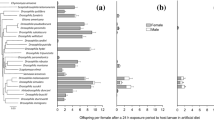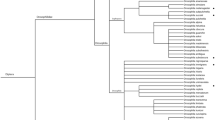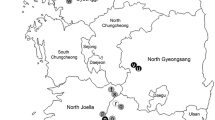Abstract
Vrestovia fidenas (Walker) (Hymenoptera: Pteromalidae) is a pupal parasitoid of Drosophila spp. native to Europe and could be useful for the biological control of the invasive spotted-wing Drosophila, Drosophila suzukii (Matsumura) (Diptera: Drosophilidae). We assessed life-table parameters (fecundity and longevity of adults, and weight and developmental time of offspring) of V. fidenas on two hosts: D. suzukii and the common native vinegar fly, Drosophila subobscura Collin (Diptera: Drosophilidae). Drosophila suzukii was determined to be a suitable host for V. fidenas and a better host than D. subobscura, i.e., V. fidenas produced more offspring and developed more rapidly on D. suzukii than on D. subobscura. The results indicate that V. fidenas should be further assessed for the biological control of D. suzukii. In addition, morphological analysis demonstrated that a second species of the genus Vrestovia, V. brevior, is also present in Europe. We present an identification key to the most common pteromalid pupal parasitoids of Drosophila, including both species of Vrestovia.




Similar content being viewed by others
References
Asplen MK, Anfora G, Biondi A, Choi DS, Chu D, Daane KM, Gibert P, Gutierrez AP, Hoelmer KA, Hutchison WD, Isaacs R, Jiang ZL, Karpati Z, Kimura MT, Pascual M, Philips CR, Plantamp C, Ponti L, Vetek G, Vogt H, Walton VM, Yu Y, Zappala L, Desneux N (2015) Invasion biology of spotted wing Drosophila (Drosophila suzukii): a global perspective and future priorities. J Pest Sci 88:469–494
Bächli G (2018) TaxoDros: The database on taxonomy of Drosophilidae http://www.taxodros.uzh.ch. Accessed 1 Jan 2018
Bächli G, Burla H (1985) Insecta Helvetica Bd. 7: Diptera—Drosophilidae. Schweizerische Entomologische Gesellschaft
Baur H (2015) Pushing the limits—two new species of Pteromalus (Hymenoptera, Chalcidoidea, Pteromalidae) from Central Europe with remarkable morphology. ZooKeys 514:43–72
Bigler F, Bale JS, Cock MJW, Dreyer H, Greatrex R, Kuhlmann U, Loomans AJM, van Lenteren JC (2005) Guidelines on information requirements for import and release of invertebrate biological control agents in European countries. Biocontrol News Inf 26:N115–N123
Bouček Z (1965) Synonymic and taxonomic notes on some Chalcidoidea (Hymenoptera), with corrections of my own mistakes. Acta Entomol Mus Natl Pragae 36:543–554
Bouček Z (1993) New taxa of North American Pteromalidae and Tetracampidae (Hymenoptera), with notes. J Nat Hist 27:1239–1313
Burton-Chellew MN, Sykes EM, Patterson S, Shuker DM, West SA (2007) The cost of mating and the relationship between body size and fitness in males of the parasitoid wasp Nasonia vitripennis. Evol Ecol Res 9:921–934
Chabert S, Allemand R, Poyet M, Eslin P, Gibert P (2012) Ability of European parasitoids (Hymenoptera) to control a new invasive Asiatic pest, Drosophila suzukii. Biol Control 63:40–47
Collatz J, Hagenbucher S, Wyss U (2019) Drosophila suzukii and native European parasitoids. Movie retrievable at: https://www.youtube.com/watch?v=xHKtbTQFAFs&feature=youtu.be
Cuthbertson AGS, Blackburn LF, Audsley N (2014) Efficacy of commercially available invertebrate predators against Drosophila suzukii. Insects 5:952–960
Eslin P, Doury G (2006) The fly Drosophila subobscura: a natural case of innate immunity deficiency. Dev Comp Immunol 30:977–983
Freitak D, Ots I, Vanatoa A, Hõrak P (2003) Immune response is energetically costly in white cabbage butterfly pupae. Proc R Soc B Biol Sci 270:S220–S222
Gabarra R, Riudavets J, Rodríguez GA, Pujade-Villar J, Arnó J (2015) Prospects for the biological control of Drosophila suzukii. BioControl 60:331–339
Harvey JA (2005) Factors affecting the evolution of development strategies in parasitoid wasps: the importance of functional constraints and incorporating complexity. Entomol Exp Appl 17:1–13
Havard S, Eslin P, Prévost G, Doury G (2009) Encapsulation ability: are all Drosophila species equally armed? An investigation in the obscura group. Can J Zool 87:635–641
Honěk A (1993) Intraspecific variation in body size and fecundity in insects: a general relationship. Oikos 66:483–492
Jervis MA, Heimpel GE, Ferns PN, Harvey JA, Kidd NAC (2001) Life-history strategies in parasitoid wasps: a comparative analysis of ‘ovigeny’. J Anim Ecol 70:442–458
Kaçar G, Wang X-G, Biondi A, Daane KM (2017) Linear functional response by two pupal Drosophila parasitoids foraging within single or multiple patch environments. PLoS ONE 12(8):e0183525
Kamijo K (1983) Pteromalidae (Hymenoptera) from Korea, with description of four new species. Ann Hist Nat Mus Natl Hung 75:295–311
Knoll V, Ellenbroek T, Romeis J, Collatz J (2017) Seasonal and regional presence of hymenopteran parasitoids of Drosophila in Switzerland and their ability to parasitize the invasive Drosophila suzukii. Sci Rep UK 7:40697
Kremmer L, Thaon M, Borowiec N, David J, Poirié M, Gatti J-L, Ris N (2017) Field monitoring of Drosophila suzukii and associated communities in South Eastern France as a pre-requisite for classical biological control. Insects 8:124
Kruitwagen A, Beukeboom LW, Wertheim B (2018) Optimization of native biocontrol agents, with parasitoids of the invasive pest Drosophila suzukii as an example. Evol Appl 11:1473–1497
Mackauer M, Sequeira R, Otto M (1997) Growth and development in parasitoid wasps: adaptation to variable host resources. In: Dettner K, Bauer G, Völkl W (eds) Vertical food web interactions, vol 130. Ecological studies. Springer, Berlin, pp 191–204
Mair P, Wilcox R (2018a) WRS2: Wilcox robust estimation and testing, version 0.10-0. https://cran.r-project.org/package=survival
Mair P, Wilcox R (2018b) Robust statistical methods using WRS2. https://rdrr.io/cran/WRS2/. Accessed 18 Feb 2019
Mason P, Everatt M, Loomans A, Collatz J (2017) Harmonizing the regulation of invertebrate biological control agents in the EPPO region: using the NAPPO region as a model. EPPO Bull 47:79–90
Mazzetto F, Marchetti E, Amiresmaeili N, Sacco D, Francati S, Jucker C, Dindo ML, Lupi D, Tavella L (2016) Drosophila parasitoids in northern Italy and their potential to attack the exotic pest Drosophila suzukii. J Pest Sci 89:837–850
Meylaers K, Freitak D, Schoofs L (2007) Immunocompetence of Galleria mellonella: sex- and stage-specific differences and the physiological cost of mounting an immune response during metamorphosis. J Insect Physiol 53:146–156
Miller B, Anfora G, Buffington M, Daane KM, Dalton DT, Hoelmer K, Rossi Stacconi MV, Grassi A, Ioratti C, Loni A, Miller JC, Ouantar M, Wang XG, Wiman N, Walton VM (2015) Seasonal occurence of resident parasitoids associated with Drosophila suzukii in two small fruit production regions of Italy and the USA. B Insectol 68:255–263
Noyes JS (2018) Universal Chalcidoidea database. http://www.nhm.ac.uk/chalcidoids. Accessed 01 Dec 2018
Offenberger M, Klarenberg AJ (1997) Hymenopteran parasitoids of Drosophila breeding in decaying herbage. NachrBl bayer Ent 46:11–19
Onagbola EO, Fadamiro HY, Mbata GN (2007) Longevity, fecundity, and progeny sex ratio of Pteromalus cerealellae in relation to diet, host provision, and mating. Biol Control 40:222–229
Prevosti A, Ribo G, Serra L, Aguade M, Balaña J, Monclus M, Mestres F (1988) Colonization of America by Drosophila subobscura: experiment in natural populations that supports the adaptive role of chromosomal-inversion polymorphism. Proc Natl Acad Sci USA 85:5597–5600
Quicke DLJ (1997) Parasitic wasps. Chapman & Hall, London
R Core Team (2018) R: a language and environment for statistical computing. R Foundation for Statistical Computing. Vienna. https://www.r-project.org/
Rogers LE, Hinds WT, Buschbom RL (1976) A general weight vs. length relationship for insects. Ann Entomol Soc Am 69:387–389
Rossi Stacconi MV, Buffington M, Daane KM, Dalton DT, Grassi A, Kacar G, Miller B, Miller JC, Baser N, Ioratti C, Walton VM, Wiman N, Wang XG, Anfora G (2015) Host stage preference, efficacy and fecundity of parasitoids attacking Drosophila suzukii in newly invaded areas. Biol Control 84:28–35
Rossi Stacconi MV, Panel A, Baser N, Loriatti C, Pantezzi T, Anfora G (2017) Comparative life history traits of indigenous Italian parasitoids of Drosophila suzukii and their effectiveness at different temperatures. JAMA 112:20-27
Rossi Stacconi MV, Amiresmaeili N, Biondi A, Carli C, Caruso S, Dindo ML, Francati S, Gottardello A, Grassi A, Lupi L (2018) Host location and dispersal ability of the cosmopolitan parasitoid Trichopria drosophilae released to control the invasive spotted wing Drosophila. Biol Control 117:188–196
Therneau T (2015) A package for survival analysis in S, version 2.38. https://cran.r-project.org/package=survival
Thistlewood HMA, Gibson GAP, Gillespie DR, Fitzpatrick SM (2013) Drosophila suzukii (Matsumura), spotted wing Drosophila (Diptera: Drosophilidae). In: Mason PG, Gillespie DR (eds) Biological control programmes in Canada 2001–2012. CABI, Wallingford, pp 152–155
Wang X-G, Kaçar G, Biondi A, Daane KM (2016a) Life-history and host preference of Trichopria drosophilae, a pupal parasitoid of spotted wing drosophila. BioControl 61:387–397
Wang X-G, Kaçar G, Biondi A, Daane KM (2016b) Foraging efficiency and outcomes of interactions of two pupal parasitoids attacking the invasive spotted wing drosophila. Biol Control 96:64–71
Warnes GR, Boker B, Lumley T, Johnson RC (2018) gmodels: various R programming tools for model fitting. R Package Version 2.18.1. https://cran.r-project.org/package=gmodels
Wilcox R (2012) Introduction to robust estimation and hypothesis testing, 3rd edn. Academic Press, Amsterdam
Wolf S, Zeisler C, Sint D, Romeis J, Traugott M, Collatz J (2018) A simple and cost-effective molecular method to track predation on Drosophila suzukii in the field. J Pest Sci 91:927–935
Yang ZQ (1996) Parasitic wasps on bark beetles in China (Hymenoptera). Science Press, Beijing
Zhu C-J, Li J, Wang H, Zhang M, Hu H-Y (2017) Demographic potential of the pupal parasitoid Trichopria drosophilae (Hymenoptera: Diapriidae) reared on Drosophila suzukii (Diptera: Drosophilidae). J Asia-Pac Entomol 20:747–751
Acknowledgements
This research project was funded by the Drosophila suzukii R & G Task Force (funded by the Swiss Federal Office for Agriculture FOAG). We thank Gary Gibson of the Canadian National Collection of Insects for loaning us specimens of Vrestovia brevior. We also thank Valeria Trivellone, Corrado Cara and Michela Meier for giving their specimens of Vrestovia brevior they collected in 2017. And thanks to Jörg Romeis and three anonymus reviewers for their valuable comments on earlier versions of this manuscript.
Author information
Authors and Affiliations
Corresponding author
Ethics declarations
Conflict of interest
The authors declare that they have no conflict of interest.
Additional information
Handling Editor: Dirk Babendreier.
Electronic supplementary material
Below is the link to the electronic supplementary material.
Rights and permissions
About this article
Cite this article
Wolf, S., Baur, H. & Collatz, J. Life history of Vrestovia fidenas, a potential control agent of Drosophila suzukii. BioControl 64, 263–275 (2019). https://doi.org/10.1007/s10526-019-09933-5
Received:
Accepted:
Published:
Issue Date:
DOI: https://doi.org/10.1007/s10526-019-09933-5




